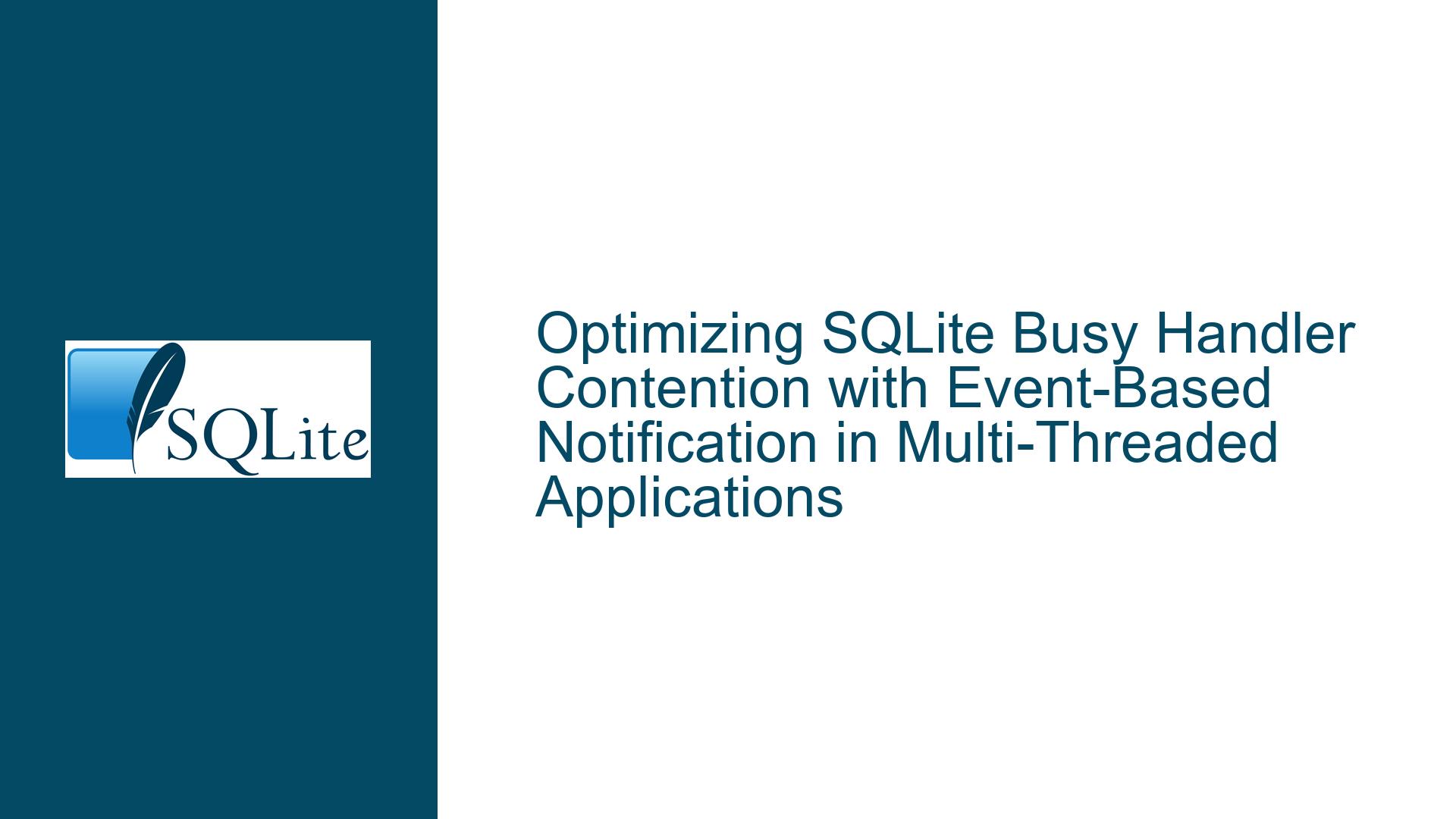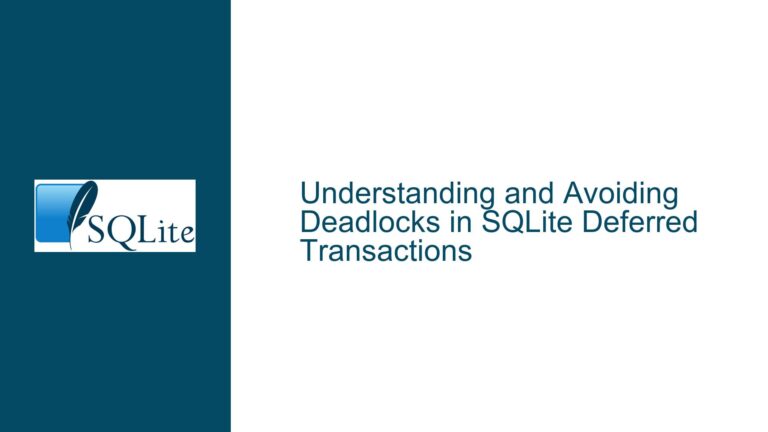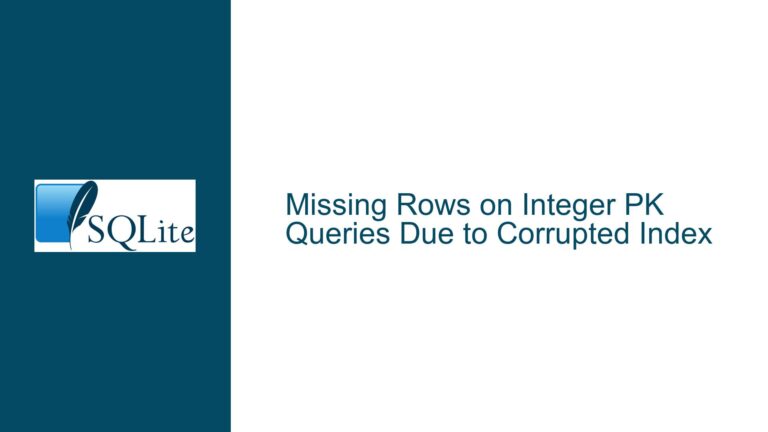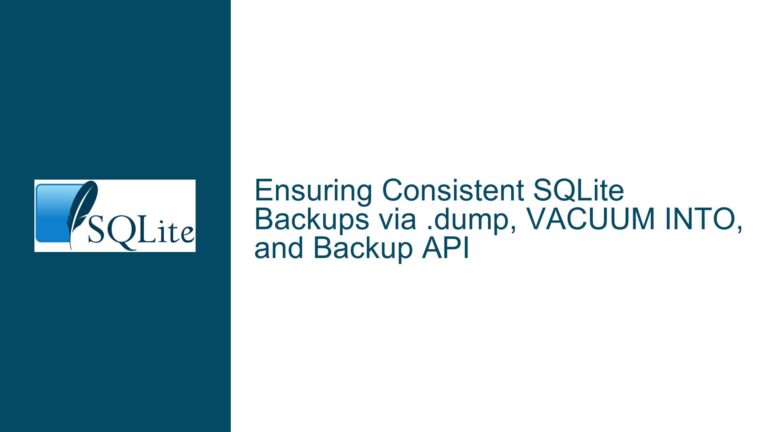Optimizing SQLite Busy Handler Contention with Event-Based Notification in Multi-Threaded Applications
Understanding SQLite Busy Handler Contention in Multi-Threaded WAL-Mode Environments
Issue Overview
SQLite’s default busy handler mechanism is designed to manage concurrent access to a database by forcing threads or processes to wait when the database is locked. In WAL (Write-Ahead Logging) mode, this mechanism ensures transactional consistency but introduces latency under high concurrency. The problem arises in multi-threaded applications where threads frequently enter a busy-wait state, even when no active write transactions are occurring. This results in idle CPU time, reduced throughput, and suboptimal resource utilization.
The core challenge stems from SQLite’s reliance on a retry-with-backoff strategy in its default busy handler. When a thread attempts to acquire a lock (e.g., for a write transaction) and finds the database busy, it invokes the busy handler callback, which sleeps for increasing intervals (up to 100ms per iteration). This approach works well for inter-process contention but becomes inefficient in single-process, multi-threaded scenarios where threads could theoretically coordinate more efficiently.
In the described scenario, threads are observed waiting in the busy handler despite the absence of active writers. This suggests either lingering lock states (e.g., due to delayed lock release by the OS or SQLite’s internal state machine) or false positives in lock contention detection. The proposed solution involves replacing SQLite’s default sleep-based busy handler with an event-driven mechanism (e.g., Windows events via WaitForSingleObject) to eliminate unnecessary sleeps and allow threads to react immediately when the database becomes available.
Key technical components involved:
- SQLite Locking States: SQLite uses a hierarchical locking model (UNLOCKED, SHARED, RESERVED, PENDING, EXCLUSIVE). In WAL mode, writers acquire the RESERVED lock early and hold it until commit, while readers operate from the WAL file.
- Busy Handler Internals: The default busy handler (
sqliteDefaultBusyCallback) uses incremental sleep intervals, which lack coordination with the actual release of locks. - Thread Synchronization Primitives: Windows events, mutexes, or semaphores could theoretically replace sleeps, but SQLite’s API does not natively support cross-thread notification.
Root Causes of Busy Handler Inefficiency in Single-Process Multi-Threaded Workloads
Possible Causes
Default Busy Handler’s Sleep-Based Backoff:
The default handler’s incremental sleep intervals (1ms, 2ms, 5ms, etc.) are optimized for inter-process contention but are suboptimal for intra-process threading. Threads cannot immediately resume when the lock is released mid-sleep, leading to unnecessary latency.Lock Release Signaling Gap:
SQLite does not provide a built-in mechanism to notify waiting threads when a lock is released. Threads relying on the busy handler must poll the lock status, creating a window between lock release and the next polling attempt.WAL-Mode Lock Retention:
In WAL mode, writers hold the RESERVED lock for the duration of their transaction. If a writer thread crashes or delays commit due to application logic, subsequent writers may perceive the database as busy even when no active I/O is occurring.Thread Scheduling Latency:
On Windows, thread wakeup after a sleep is subject to scheduler granularity (typically 15.6ms). A thread sleeping for 1ms may actually wait 15ms before resuming execution.False Contention from Read Transactions:
Long-running read transactions (e.g.,SELECTstatements with large result sets) can block writers by holding SHARED locks, triggering busy handlers in writer threads.SQLITE_BUSY vs. SQLITE_LOCKED Ambiguity:
Misinterpretation of these error codes can lead to incorrect busy handler usage.SQLITE_BUSYindicates a locked database, whileSQLITE_LOCKEDrefers to a locked table. Applications may fail to distinguish them, causing unnecessary retries.
Event-Driven Busy Handlers, Lock Coordination, and Architectural Mitigations
Troubleshooting Steps, Solutions & Fixes
Step 1: Diagnose Contention Source
Verify whether contention is intra-process (threads within the same application) or inter-process (external processes accessing the database). Use SQLite’s sqlite3_db_status(SQLITE_DBSTATUS_LOOKASIDE_USED) or monitor the -wal and -shm files to identify external writers. For intra-process scenarios, proceed with the following optimizations.
Step 2: Implement a Custom Busy Handler with Event Synchronization
Replace the default busy handler with a callback that waits on a Windows event object instead of sleeping:
int customBusyHandler(void *pEvent, int retries) {
HANDLE hEvent = (HANDLE)pEvent;
DWORD timeout = calculateTimeout(retries); // E.g., exponential backoff cap
return (WaitForSingleObject(hEvent, timeout) == WAIT_OBJECT_0) ? 1 : 0;
}
Integration Steps:
- Create a global event:
HANDLE g_dbEvent = CreateEvent(NULL, FALSE, FALSE, NULL); - Install the handler per connection:
sqlite3_busy_handler(db, customBusyHandler, g_dbEvent); - Signal the event after committing a transaction:
sqlite3_exec(db, "COMMIT;", NULL, NULL, NULL); SetEvent(g_dbEvent);
Caveats:
- Race Conditions: A thread may signal the event before waiters begin listening. Use a manual-reset event and reset it after signaling to avoid missed notifications.
- Over-Signaling: Frequent events can cause CPU thrashing. Combine with a lock-free queue to track waiting threads.
Step 3: Application-Level Writer Serialization
Adopt a global mutex or semaphore to serialize write transactions, reducing lock contention:
HANDLE g_writeMutex = CreateMutex(NULL, FALSE, NULL);
void executeWriteTransaction(sqlite3 *db, const char *sql) {
WaitForSingleObject(g_writeMutex, INFINITE);
sqlite3_exec(db, "BEGIN;", NULL, NULL, NULL);
// Execute SQL
sqlite3_exec(db, "COMMIT;", NULL, NULL, NULL);
ReleaseMutex(g_writeMutex);
}
This approach eliminates SQLITE_BUSY errors for writes but requires careful handling of read transactions to avoid blocking.
Step 4: VFS Shim for Lock State Notification
Develop a custom VFS layer to intercept lock/unlock operations and signal events:
// Custom xLock method
int xLock(sqlite3_file *pFile, int eLock) {
int rc = pOriginalVfs->xLock(pFile, eLock);
if (eLock == SQLITE_LOCK_NONE) {
SetEvent(g_dbEvent); // Signal unlock
}
return rc;
}
Implementation Notes:
- Override
xLock,xUnlock, andxFileControlmethods to track lock state transitions. - Ensure thread safety using atomic operations or critical sections.
Step 5: Dedicated Writer Thread with Task Queue
Delegate all write transactions to a single thread, eliminating writer-writer contention:
// Producer-Consumer queue for SQL commands
std::queue<std::string> writeQueue;
CRITICAL_SECTION queueCs;
HANDLE hQueueEvent = CreateEvent(NULL, FALSE, FALSE, NULL);
DWORD WINAPI writerThread(LPVOID lpParam) {
sqlite3 *db = initializeDatabase();
while (true) {
WaitForSingleObject(hQueueEvent, INFINITE);
EnterCriticalSection(&queueCs);
std::string sql = writeQueue.front();
writeQueue.pop();
LeaveCriticalSection(&queueCs);
executeSql(db, sql);
}
return 0;
}
Advantages:
- Readers and writers never contend directly; writers are serialized naturally.
- Simplifies error handling and transaction rollback.
Step 6: Tuning WAL Mode Parameters
Adjust WAL auto-checkpoint and shared memory settings to minimize lock retention:
PRAGMA wal_autocheckpoint = 1000; -- Checkpoint after 1000 pages
PRAGMA journal_size_limit = 1048576; -- Limit WAL file to 1MB
Impact: Smaller WAL files reduce the time required for checkpoints, which temporarily acquire RESERVED locks.
Step 7: Monitoring and Profiling Tools
Use SQLite’s built-in profiling interfaces to identify contention hotspots:
sqlite3_profile(db, profileCallback, NULL);
void profileCallback(void *pArg, const char *sql, sqlite3_uint64 ns) {
if (ns > 100000000) { // Log queries >100ms
logLongRunningQuery(sql, ns);
}
}
Cross-reference with Windows Performance Analyzer (WPA) traces to correlate SQLite operations with thread scheduler activity.
Final Recommendation:
For single-process applications, combine a custom busy handler with application-level writer serialization. This hybrid approach minimizes code complexity while ensuring timely lock acquisition. For high-throughput scenarios, adopt a dedicated writer thread to eliminate contention entirely.
This guide provides a comprehensive framework for diagnosing and resolving SQLite busy handler contention in multi-threaded Windows applications. Each solution is modular, allowing incremental adoption based on specific performance requirements and architectural constraints.






